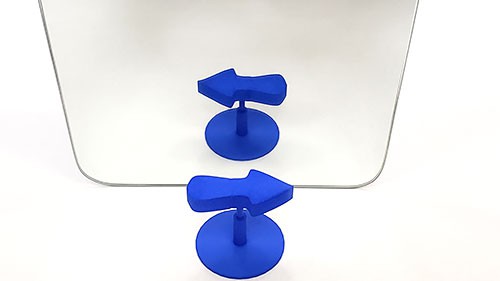Summary
10-20 minutes
Up to 1 day
3D printing, optical illusions
Ben Finio, PhD, Science Buddies
Optical illusion designed by Prof. Kokichi Sugihara
Introduction
Make your own 3D printed “impossible arrow” illusion in this fun activity. No matter how many times you spin the arrow around, it always seems to point in the same direction—but its reflection in a mirror points the other way! How does it work? Try it and find out!
Materials
Instructions
-
Download the STL file for the impossible arrow and the support piece from the materials section.
-
Print the files on your printer or send them to an online 3D printing service.
-
Place the arrow on top of the support so it can rotate.
-
Look at the arrow from above at roughly a 45-degree angle.
Which way is the arrow pointing?
-
Use your finger to rotate the arrow 180 degrees.
Which way is the arrow pointing now?
-
Keep trying to rotate the arrow.
Can you ever get it to point in the other direction?
-
Put the arrow in front of a mirror.
Which direction does the arrow’s reflection point?
-
Rotate the arrow again.
Which way do the arrow and its reflection point now?
-
Take the arrow off the support. Look at it from directly above, then from the side. Try rotating it while viewing it from the top or the side.
Is the object truly arrow-shaped? Does the illusion still work when you look at it from the top or the side?
What Happened?
This arrow seems impossible! No matter how many times you rotate it, it always seems to point to the right, and its reflection in the mirror always points to the left! This illusion only works, however, when viewing the arrow from a certain angle. If you look at it from directly above or from the side, it does not look like an arrow at all, and the illusion disappears.
Digging Deeper
If this arrow’s behavior seems physically impossible, you are right. It is an optical illusion. The object is carefully designed to look like an arrow only when viewed from above at about a 45-degree angle. If you look at the object from the side or from directly above, you will see its true shape.
You will also notice that the top and bottom surfaces of the shape are curved, not flat. When you view the shape from an angle, though, your brain tends to misinterpret the top surface as flat and adjust its perception accordingly. Your brain is tricked into thinking it sees an arrow that always points in one direction.
See the publication by Professor Kokichi Sugihara in the Related Resources section for more examples of seemingly impossible shapes!

Ask an Expert
Curious about the science? Post your question for our scientists.
For Further Exploration
- Try the illusion on other people. Can they figure out how it works?
- What factors affect the illusion? For example, what range of viewing angles works for the illusion? Do lighting conditions (e.g., soft lighting versus harsh shadows) have any effect?
Activities
STEM Activity
Is it a circle? Is it a square? Or is it both? Make your own 3D printed “ambiguous cylinder” illusion in this fun activity.
Links
Explore Our Science Videos
Video: How to Balance Anything
How To Build a Rube Goldberg Machine
Paper Ball Run: 2022 Engineering Challenge


